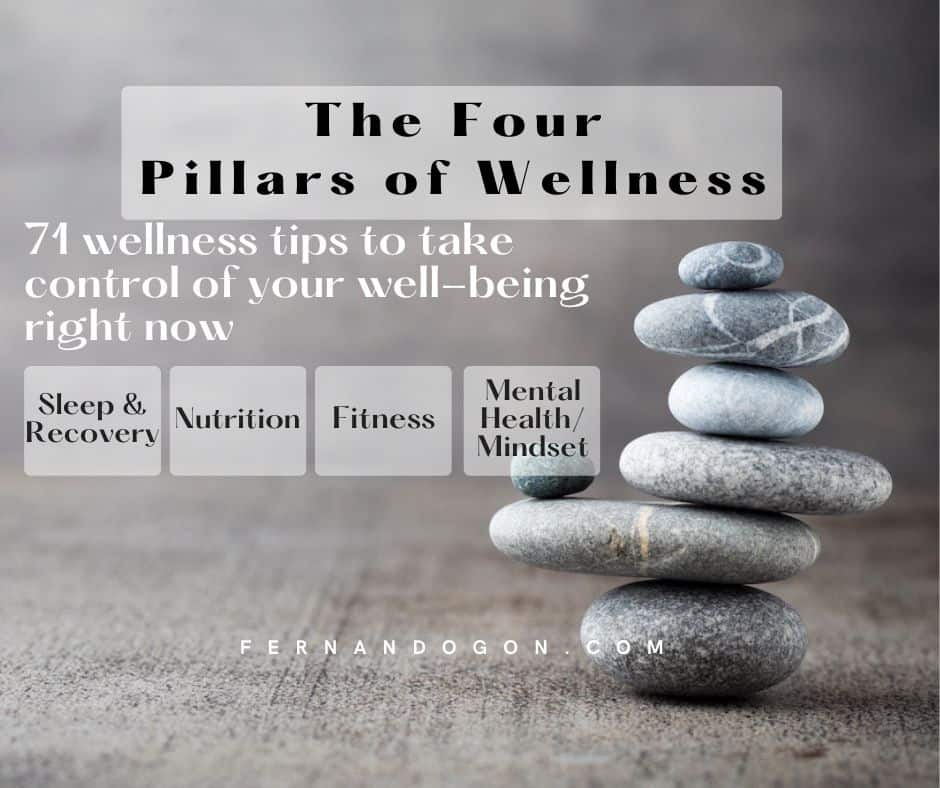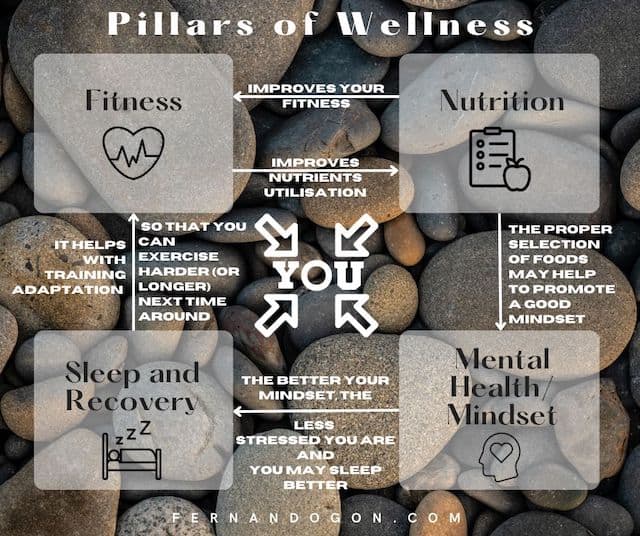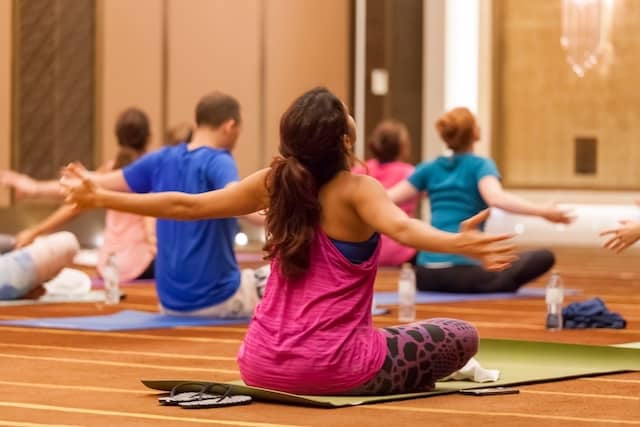71 Wellness Tips

Are you looking for simple wellness tips to improve your overall health? By taking small steps daily towards improving your mental, physical, and emotional health, you’ll be surprised at how much healthier and happier you can become! To give you a head start on boosting your wellness, here are 71 simple health and wellness tips that will help you take control of your well-being right now.
Biohacking is often referred to as “DIY” health optimization because it encourages individuals to take their health into their own hands through self-observation and experimentation.
When biohacking for wellness, you will often use different tools, such as nutrition, supplements, herbal medicine, exercise, sleep optimization strategies and lifestyle changes, to optimize your health by gaining control of your biology and environment.
Through biohacking, people can discover which tools work best for them and make changes to reach their desired level of wellness.
The aim of biohacking is not necessarily to become superhuman but rather to give you the power to improve without relying solely on traditional medical treatments or pharmaceuticals.
Table of Contents

Here is your list of 71 easy health and wellness tips to improve your health right now:
1. Schedule a wellness check-up with your doctor.
A conversation with your doctor can identify issues you haven’t noticed and help you put mitigation strategies in place.
Scheduling regular check-ups with your doctor is an essential part of maintaining good health and wellness and may help detect conditions before they become more serious, which can save you money in the long term and even potentially save your life. It also provides a chance to discuss any lifestyle changes which can improve overall health, and it gives you time to ask questions about concerns for physical or mental well-being so that you can be as informed as possible about your health and receive guidance from an experienced medical professional.
2. Quit smoking
As per the Harvard School of Public Health, smoking is one of the top three preventable causes of death in the U.S. You can read the full article here.
Quitting smoking is an essential step in making lifestyle changes for improved health. While quitting smoking may be difficult, it can lower the risk of developing lung cancer, heart disease and other illnesses. Quitting also improves blood circulation and lung capacity, which can help exercise become easier and increase energy levels. Additionally, it will help prevent the effects of second-hand smoke on those around you who don’t smoke. Taking the necessary steps to quit smoking can improve overall wellbeing and quality of life for everyone.
Wellness tips on Sleep and Recovery

3. Set up your weekly routine schedule for healthy sleep
A regular sleeping schedule can help regulate hormone levels that may have an effect on appetite, energy levels, anxiety, concentration and overall a healthy lifestyle. It also ensures that your body has time to recover from physical and mental fatigue.
4. Get enough sleep
Aim for at least 7-9 hours per night. The best is to track your sleep using a monitor, which can be a valuable tool in helping to monitor and improve it, as it measures how long you’re sleeping and when and also tracks sleep cycles, heart rate, and other important metrics.
5. Use red light therapy
Red light therapy is a form of phototherapy that has an energizing effect on the body, promoting circulation and stimulating mitochondrial function, which can lead to improved energy levels and reduced fatigue. It is also believed to have potential benefits in healing wounds, fighting some skin conditions, reducing inflammation and to enhance skin health.
6. Hot therapy
It can be used to reduce inflammation or swelling in the body, relax tense muscles, improve circulation and reduce muscle spasms. The combination of heat and massage therapy may help stimulate the body’s natural healing process to speed up recovery.
7. Cold therapy
It is believed that cold therapy is a great way to boost your immune system, reduce inflammation and may help release endorphins, allowing you to fall asleep faster and easier. To take advantage of cold therapy’s benefits, you don’t need an expensive cool room – a simple cold shower or a bath with water and ice is enough to stimulate these positive effects.
8. Compression therapy
Compression apparel improves circulation and fluid movement within the body and is believed to help reduce muscle soreness after a workout. Wearing compression socks or tights for a few hours post-exercise could be an easy way to lessen inflammation and recover quickly. Numerous other options are also available, including arm sleeves and compression shorts.
9. Reduce screen time
Too much time spent in front of screens can lead to sleep deprivation, fatigue, poor posture, headaches, eye strain, and more. It also impacts our mood and sense of personal connection with others as we’re left feeling overwhelmed and disconnected from real life. Limiting your screen time can be beneficial for improving focus and productivity while encouraging healthier habits such as exercise hence a healthy lifestyle.
10. Reduce blue light at night 2-3 hours before bed
Wearing blue light filter glasses in the evening can help protect your eyes from the harmful effects of blue light while also helping to regulate your sleep-wake cycle, so you can wake up feeling refreshed and better prepared for the day ahead.
11. If you watch a lot of TV, plan to stand up 60% of the watching time
Sitting for too long can lead to an increased risk of obesity, heart disease, stroke, poor circulation, and weak muscles in your core and legs, leading to poor posture and back pain. Regular movement and activity throughout the day are key for keeping your body healthy and providing physical wellness.
12. Relax
Taking time to relax is essential for maintaining both physical and mental wellbeing. Meditation, yoga, or deep breathing exercises can help to slow down your thoughts, reduce stress hormones such as cortisol, and increase endorphins like serotonin – the ‘feel-good hormone’. These daily activities can help you manage anxiety, enabling you to think more clearly and stay focused throughout the day.
13. Be kind to yourself
Treating yourself as if you were a close friend and having a positive mindset is important to maintaining self-care and looking after yourself. It’s easy to be harsh on yourself and set unrealistic expectations, but speaking to yourself in a kind, positive manner can make all the difference.
14. Connect with nature
Take regular walks in parks or the countryside for additional relaxation and stress relief benefits.
15. Exercise to improve sleep
Exercising daily can do wonders for your sleep quality and energy levels. Not only will it help you to get a better night’s rest, but it also increases the amount of time spent in deep, restorative stages of sleep.
16. Relax in a warm bath once a week
Epsom salt baths can help relieve muscular tension, and magnesium may help to reduce muscle cramping.
Wellness tips on Nutrition

Biohacking your nutrition can offer numerous benefits, such as improved immunity, increased energy levels, better focus and mental clarity. In general, having a healthy diet will improve your wellbeing and may help you lose weight. Optimizing your nutrition through biohacking allows you to experience long-term improvements without relying on fad diets or extreme protocols. Biohacking can also improve your performance in exercise and other activities. These nutrition wellness tips are powerful tools for unlocking the best version of yourself!
Go to the “>>> FREE STUFF <<<” page to download your free recipe ebook NOW and start eating healthy.
17. Drink plenty of water throughout the day (at least eight glasses)
Medical News Today explains the benefits of drinking water.
18. Track your daily calories
Tracking the calories you eat at least one week per month can keep you on track when trying to maintain a healthy weight and may facilitate modifying your eating pattern if necessary.
Without tracking, you won’t know how many calories you are consuming and potentially end up gaining weight.
19. Eat a well balanced diet full of fresh fruits and vegetables, whole grains, and healthy fats
Eating a balanced diet full of fresh ingredients and leafy greens as part of your daily routine can help boost your energy levels, improve your mental clarity, support immunity, and even strengthen bones and muscles. Eating from all food groups also ensures you get the right amount of essential nutrients such as vitamins, minerals and fibre. It may also help you to improve your mood.
Go to the “>>> FREE STUFF <<<” page to download your free recipe ebook NOW and start eating healthy.
20. Include lean protein in every meal
In this article, the Diet Doctor discusses the benefits and importance of protein, which includes bone health, among others.
21. Include oily fish like salmon in your diet
Studies suggest oily fish and Omega-3 intakes are suboptimal across our lifespan.
Omega-3 fatty acids are considered the “good” type of fat. They can help reduce inflammation, support heart health, and enhance mental clarity. Omega-3 fatty acids can be found in fish such as salmon, herring and mackerel, as well as in some plant foods like walnuts and flaxseed.
22. Consume enough fiber
The National Institutes of Health on this article explains that getting enough fiber when you eat whole grains, vegetables, beans, and pulses may be beneficial to your digestive system. Supplementing with a fiber supplement can also be beneficial to aid digestion.
23. Maximise your intake of vitamins, minerals and antioxidants
Real food can provide an abundance of vitamins, minerals and antioxidants that are essential for optimal wellness. Fresh fruits, vegetables, whole grains, beans, nuts and seeds are all packed with essential nutrients that can help support overall well-being. Additionally, certain supplements like daily probiotics and multivitamins might help eliminate any nutritional gaps.
24 Incorporate intermittent fasting into your lifestyle
Intermittent fasting can be a beneficial way to give the body a break from constantly digesting food. It can also help with weight loss, improve metabolism, and reduce inflammation. Intermittent fasting involves taking short breaks from food consumption, such as going 16 hours between dinner and breakfast or having an 8-hour eating window within a 24-hour day.
25. Get enough vitamin D
Vitamin D is found in fatty fish, eggs, fortified dairy products, some mushrooms, and certain supplements. In addition to these sources, getting regular exposure to sunlight is one of the best ways to get your daily dose of vitamin D since it stimulates the body’s production.
26. Reduce the consumption of processed foods and sugar intake
Try to go one day a week without fast food. It may help you achieve a healthy gut with the extra benefit that may assist with weight loss. Always try to look for and eat healthier alternatives.
27. Reduce the consumption of drinks with added sugar
It may help to reduce overall caloric intake and lower the risk of developing chronic diseases like diabetes and obesity. Consuming too much sugar can cause a number of negative health effects, including increased risks for tooth decay, heart disease, high blood pressure, and liver problems, whilst also helping to limit your exposure to unhealthy additives like artificial flavours and colours.
28. Practice mindful eating habits
Practising mindful eating habits by eating slowly and savouring foods can help to promote healthier, more balanced eating patterns, reduce the risk of overeating, and improve overall nutrition. Mindful eating encourages awareness of fullness cues so that you can be more aware of when to stop eating. Additionally, it can help to bring a sense of calm to a mealtime experience by slowing down and being present in the moment.
29. Choose organic foods if your budget allows it
Organic food is becoming increasingly popular as people become more conscious of their health and the environment. The quality and nutritional value of organic foods can vary, but overall they tend to be a healthier option than conventionally produced food. They are grown without the use of synthetic fertilizers, growth hormones, GMOs, radiation or other potentially harmful chemicals.
30. Drink herbal teas

According to research, green, black, and other herbal teas may have antimicrobial properties.
31. Include superfoods like mushrooms in your daily life habits
It contains several powerful compounds that have been shown to have numerous benefits, including boosting immunity, improving digestion, may reduce inflammation in the body, and many varieties of mushroom tea are known for their calming effects.
32. Avoid crash diets
Attempting to slim down quickly by drastically reducing food intake might seem like a good idea at first. However, crash diets such as juice fasts/cleansing can have the opposite effect over time. This type of diet has been known to slow metabolism and even result in weight gain in the long run.
33. Include fermented foods in your diet
They offer an array of probiotics, enzymes, vitamins and minerals. Commonly fermented foods include sauerkraut, kombucha, tempeh, miso soup, pickles and yogurt. Including fermented foods in your everyday life is a great way to get essential nutrients while adding variety to your diet.
34. Cook meals at home whenever possible
It may help with portion control and a balanced nutrition, as you’ll know exactly what ingredients you use in your meals. Cooking may also help you to improve mood.
35. Have a microbiome test done
Get a microbiome test to help you determine the ideal food recommendations for you. Also, the test will help you track any changes in your microbiome status.
36. Have a food sensitivity test done
Food sensitivity tests, though controversial, are useful in solving many problems concerning gut health. Also, they have proved to be a reliable solution for rectifying allergies.
Wellness tips on Fitness

Biohacking your body through exercise is a great way to optimize your physical and mental performance. Exercise releases endorphins, which can increase energy levels, boost mood, and help you sleep better. It also increases blood flow to the brain and helps you think more clearly. Exercise also strengthens muscles and bones, helps maintain a healthy weight, reduces the risk of chronic diseases, boosts immunity, and improves the overall quality of life. Regular exercise can even help reduce stress and anxiety levels by elevating natural chemicals that make us feel calmer. By biohacking your body through exercise, you will be able to take control of your health and make sure that you are performing at your best.
37. Exercise regularly
Aim for 30 minutes of physical activity daily. And always remember to stay hydrated.
38. Add strength training to your exercise routine
Harvard Medical School in the article: Strength training builds more than muscles explains the benefits of strength training, which can help build and maintain muscle mass and strength, which leads to strong bones, and strong bones can help minimize the risk of fracture due to osteoporosis. These are enough reasons to include strength training as part of your regular physical activity dairy.
39. Weightlifting as strength training
Strength training can provide many benefits, such as increased muscle mass, improved coordination and balance, increased bone density, and improved body composition.
40. Resistance band exercises as strength training
Resistance bands offer the convenience and versatility needed to build strength without the need for bulky weights or gym equipment and provides many of the benefits mentioned previously.
41. Kettlebell workouts as strength training
Kettlebells are weighted balls with handles used for explosive exercises intended to increase strength and power.
42. Go for a walk
Even just 10 minute short walk can do wonders for improving mood and overall wellbeing! The Harvard School of Public Health recommends walking 10,000 steps every day.
43. Warm-up and stretch
The Harvard Medical School article: The importance of stretching explains that stretching increases your range of motion, keeps the muscles flexible, strong, and healthy and should be done daily. Warming up and stretching are both important to prevent injury.
44. Attend a fitness class at your local gym
Fitness classes can be a great way to exercise in a fun and supportive environment. Group classes offer a sense of camaraderie, which can motivate you to work hard. They are structured and are led by instructors who can offer pointers, tips and helpful modifications as needed.
45. Group fitness classes
Group fitness classes provide a great way to get motivated and stay motivated for your workouts by connecting with others who have similar goals in mind.

46. Sign up and attend fitness classes online
Online fitness classes are a great way to stay fit and active from the comfort of your home. Virtual classes offer the same benefits as in-person classes, such as structure, with the added convenience of attending anytime, anywhere.
47. Circuit training
This type of workout combines multiple exercises targeting different muscle groups rather than isolating one particular area at a time, resulting in an effective full-body workout completed in a short period of time.
48. High-intensity interval training (HIIT)
This type of exercise involves short bursts of intense activity followed by periods of rest. HIIT has been shown to improve cardio endurance and calorie burning more efficiently than traditional aerobic exercise. Examples of HIIT workouts can be found here.
49. Jump rope workouts
Jump ropes are inexpensive pieces of equipment that can be used to improve your agility while boosting endurance and strength.
50. Join a Yoga class
Yoga is an ancient practice that improves flexibility and balance while also calming the mind and body. There are lots of Yoga classes, either face-to-face or online classes.
51. Join a Pilates class
Pilates is a form of exercise that focuses on core stability and is designed to improve posture, balance, coordination, strength, and flexibility.
52. Barefoot walking
Barefoot walking is a fantastic way to connect with nature and promote good health and a sense of peace and relaxation. The feeling of walking without shoes on can be liberating and increases body awareness, as it allows you to experience the natural world around you more fully.
53. Stability ball exercises
Stability balls make any movement more challenging, which helps engage additional muscles while toning up faster.
Wellness tips on Mental health and Mindset

54. Practice gratitude
Give gratitude more often by finding something positive in every situation; this simple yet powerful practice has been proven to boost happiness levels significantly.
55. Take up a new hobby
Invest time into pursuing passions and hobbies that bring joy to your life – research shows that doing something you love helps create meaning and purpose within your life, which in turn can lead you towards greater life satisfaction overall!
56. Or, don’t take up a new hobby if….
If you already have a hobby that you already practice and enjoy, then focus on this and develop your skills on it. Learning new things may help you take a new perspective in life.
57. Incorporate some playtime into your routine
It includes anything from playing board games, taking an art class or dancing around with friends or family members.
58. Keep in touch with friends and family
Spending time socializing and having quality face-to-face conversations can help ward off depression symptoms and reduce anxiety levels in people of all ages!
59. Have some alone time
This practice can help us connect with our inner selves, develop a better understanding of ourselves as individuals, and grow spiritually. Having some alone time is an essential part of self-care that can help improve our emotional intelligence, productivity, and overall life satisfaction.
60. Set aside “me-time”
Where you can unwind without distractions, use this period for relaxation, such as reading a book or journaling out any thoughts & feelings that may have been weighing heavily on your mind!
61. Bring along a friend or a family member with you on your wellness journey
A friend or a family member will enable you to share ideas and encourage each other along the way.
62. Practice deep breathing exercises
Deep breathing may help manage stress and reduce cortisol levels in the body, which can help relieve stress over time.
63. Practice progressive muscle relaxation techniques
Progressive muscle relaxation is a technique designed to reduce stress and improve mood, increase body awareness, and enhanced feelings of inner peace.
64. Practice visualization meditations
Visualization meditations are a type of mindfulness practice that involves creating an image or scene in your mind’s eye and focusing on it to calm your body and mind. This practice can promote better sleep, encourage positive thinking and visualization for goal setting, and enhance our ability to connect with our inner wisdom.
65. Find a purpose in life
Finding purpose in life can help bring clarity and focus to our daily lives. Having a clear sense of our personal values, goals, and beliefs allows us to create meaningful connections with our environment, which can lead to improved mental health.
66. Keep yourself motivated
By creating SMART goals (specific, measurable, achievable, realistic & timely), breaking down larger tasks into smaller bite sized pieces & rewarding yourself whenever you achieve something big (or small!)
67. Establish healthy boundaries with yourself & others
Healthy boundaries are essential for maintaining healthy and respectful relationships with others. Healthy boundaries can also help us take responsibility for our feelings, needs, and emotions, allowing us to live a more balanced life.
68. Write it down
Writing it down could be your outlet if you feel overwhelmed or upset. Taking the time to express your emotions on paper can help you process what’s been bothering you, and it could be just what you need!
69. Practice forgiveness
Practising forgiveness is an important life skill that can lead to a healthier and more peaceful existence. It also encourages compassion and understanding towards ourselves and others, which can help to improve our relationships with people around us. Practising forgiveness can ultimately lead to greater emotional well-being, a more positive outlook on life, and increased feelings of joy.
70. Smile and laugh
Although it may not feel natural at first, forcing yourself to smile can greatly slow your heart rate and settle your nerves. Doing something that allows you to laugh genuinely can also help to elevate how you’re feeling. It doesn’t have to be anything big – even just watching a funny video or telling a joke can make a difference.

71. Send a thank you note
Sending someone a thank you note is a great way to show your appreciation and kindness. It helps to keep relationships strong and creates a sense of connection. Also, it can make the recipient feel happy and special, which we all need more these days!
Conclusion
Taking the initiative to develop and implement strategies that can improve your overall wellness. These activities can help you relax, recharge, and increase your vitality. Spending time on self-care activities like practising mindfulness, exercising, eating nutritious meals and getting enough sleep will help us lead happier. healthier and longer lives.






